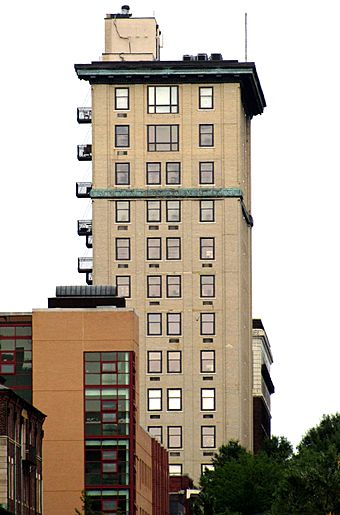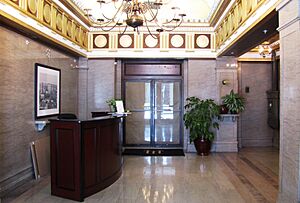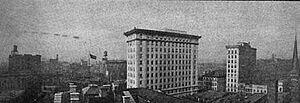The Holston facts for kids
Quick facts for kids |
|
|
Holston National Bank
|
|

The Holston
|
|
| Location | 531 S. Gay St. Knoxville, Tennessee |
|---|---|
| Area | .17 acres (690 m2) |
| Built | 1913 |
| Architect | John Kevan Peebles |
| Architectural style | Neoclassical Revival |
| NRHP reference No. | 79002446 |
| Added to NRHP | October 2, 1979 |
The Holston is a tall building in Knoxville, Tennessee. It's now a condominium building, which means it has many apartments owned by different people. It stands at 531 South Gay Street.
This building was finished in 1913. It was first built as the main office for the Holston National Bank. For a while, it was the tallest building in Knoxville. That changed when the Andrew Johnson Hotel was built later in the 1920s.
A famous architect named John Kevan Peebles designed The Holston. It's special because it's the only tall building in Knoxville built in the Neoclassical Revival style. This style looks back to ancient Greek and Roman designs. In 1979, The Holston was added to the National Register of Historic Places. This was because of its unique design and its important place in the city's skyline.
The Holston National Bank started in 1890. By 1913, it was one of Knoxville's biggest banks. They built the first twelve floors of The Holston building then. In 1928, the bank merged with another bank, Union National. They became Holston-Union, the largest bank in Knoxville. They added the thirteenth and fourteenth floors at this time.
However, the new bank faced problems during the Great Depression in 1930. It closed down. Another bank, Hamilton National Bank of Knoxville, took its place in 1931. For the next 40 years, Hamilton National was Knoxville's largest bank. In 1975, United American Bank took over Hamilton National. The new bank later moved its main office to a different building.
Building Design
The Holston is a fourteen-story building. It sits on a lot that is about 50 feet by 140 feet. This is at the corner of Gay Street and Clinch Avenue. Most of the building is made of light yellow brick.
The first three floors on Gay Street and Clinch Avenue are covered in Tennessee marble. The front on Gay Street has four large Ionic columns. These columns are part of a slightly set-back area. The main entrance is in the middle. It has a triangular top called a pediment. Above the entrance, you can see the Roman numerals MDCCCCXII, which means "1912". The entrance and first-floor windows have flower-like decorations called rosettes.
On the Clinch Avenue side, there are flat columns called pilasters. These support a decorative band called an entablature. This band has special patterns like triglyphs and metopes. The roof has a large metal cornice around it. This cornice was part of the original 1913 design. It was moved higher in 1928 when the top two floors were added.
Between the eleventh and twelfth floors, there is a carved band called a frieze. This goes across both the Gay Street and Clinch Avenue sides of the building.
Inside, the Holston was updated in 1977. But some original parts are still there. The entrance foyer has a curved ceiling. This ceiling has plaster rosettes. There is also a frieze with triglyphs and metopes.
Building History
The Holston National Bank started on January 17, 1890. It was first called the Holston Banking and Trust Company. The next year, it became a national bank, the Holston National Bank. H. M. Aiken was the first president. Hugh McClung took over in 1897.
In 1912, Holston National started building its new main office. This was at 531 South Gay Street. John Kevan Peebles, an architect from Virginia, designed the building. The George A. Fuller Company from New York built it. A local company, Fenton Construction, did the marble work. The interior wood was done by Edgefield and Nashville Manufacturing Company from Nashville.
The building opened on June 16, 1913. It became the tallest building in Knoxville. It was taller than the Burwell Building, which was across the street.
In 1928, Holston National Bank joined with Union National Bank. They formed Holston-Union National. This new bank became the biggest in Knoxville. Joseph Gaut, who had been president of Holston for a long time, stepped down. J. Basil Ramsey became the new president.
However, the Wall Street Crash of 1929 caused many banks to fail. On November 10, 1930, many people tried to take their money out of Holston-Union. This is called a bank run. The bank had to close.
In 1931, the Hamilton National Bank of Knoxville opened in The Holston building. It replaced Holston-Union. The new bank worked hard to earn people's trust again. They made sure they had more money saved than they had loaned out. By 1940, Hamilton National was the biggest bank in Knoxville. It stayed the largest bank into the 1970s.
In 1974, two people, Dean Moses and Jake Butcher, tried to take control of Hamilton National Bank. This started a competition to buy the bank's shares. In February 1975, Jake Butcher's United American Bank bought Hamilton National. The two banks merged. The new bank built a new, taller main office called the Plaza Tower. But they still kept a branch office in The Holston building.
Later, in the 21st century, a company called Dewhirst Properties changed The Holston. They turned it into fancy condominiums. In 2008, an apartment in The Holston was the first in Knoxville to sell for over $1 million.



